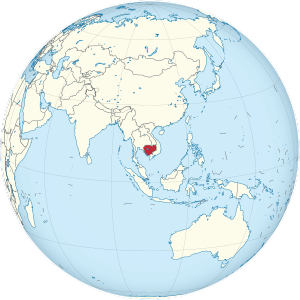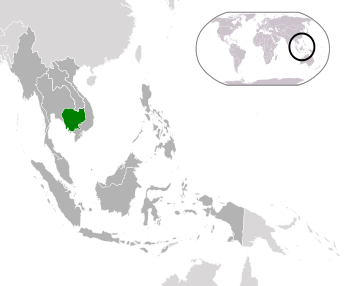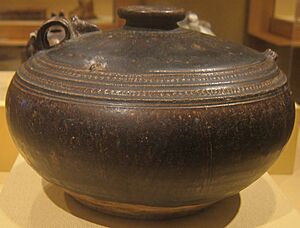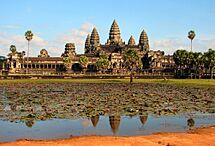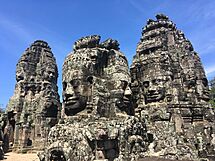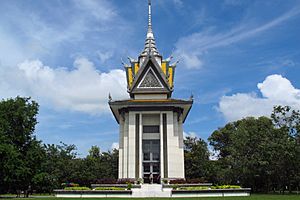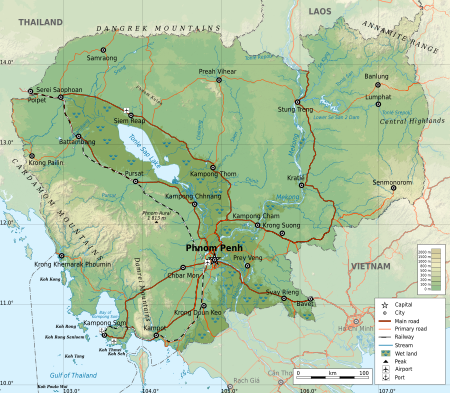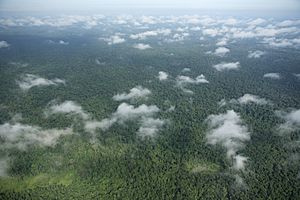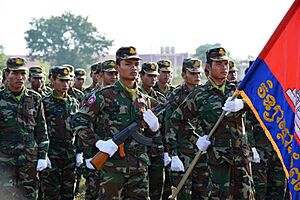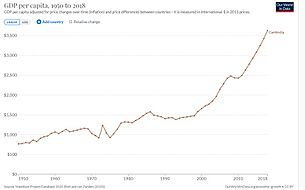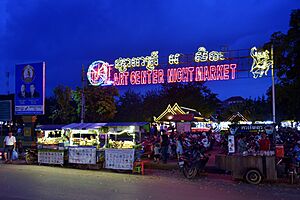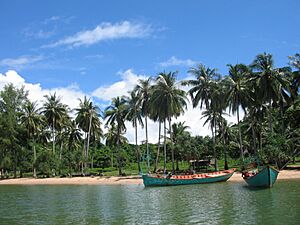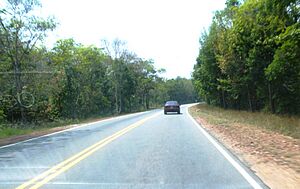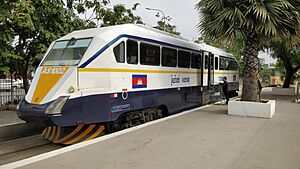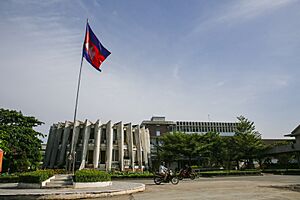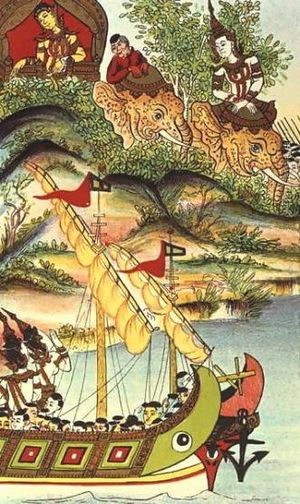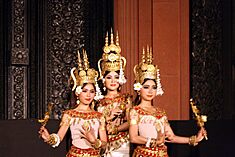Cambodia facts for kids
Quick facts for kids
Kingdom of Cambodia
|
|
|---|---|
|
|
|
|
Motto: ជាតិ សាសនា ព្រះមហាក្សត្រ
|
|
|
Anthem: នគររាជ
|
|
| Capital and largest city
|
Phnom Penh 11°34′10″N 104°55′16″E / 11.56944°N 104.92111°E |
| Official languages | Khmer |
| Official script | Khmer |
| Ethnic groups
(2019/20)
|
|
| Religion
(2019)
|
|
| Demonym(s) | Cambodian |
| Government | Unitary parliamentary constitutional elective monarchy under an authoritarian hereditary dictatorship |
|
• Monarch
|
Norodom Sihamoni |
| Hun Manet | |
|
• President of the Senate
|
Hun Sen |
| Legislature | Parliament |
| Senate | |
| National Assembly | |
| Formation | |
|
• Funan
|
68–550 |
|
• Chenla
|
550–802 |
| 802–1431 | |
| 1431–1863 | |
|
• French protectorate
|
11 August 1863 |
|
• Independence from France
|
9 November 1953 |
| Area | |
|
• Total
|
181,035 km2 (69,898 sq mi) (88th) |
|
• Water (%)
|
2.5 |
| Population | |
|
• 2024 estimate
|
17,638,801 (71st) |
|
• Density
|
94.4/km2 (244.5/sq mi) |
| GDP (PPP) | 2025 estimate |
|
• Total
|
|
|
• Per capita
|
|
| GDP (nominal) | 2025 estimate |
|
• Total
|
|
|
• Per capita
|
|
| Gini (2013) | 36.0 medium |
| HDI (2023) | medium · 151st |
| Currency |
|
| Time zone | UTC+07:00 (ICT) |
| Calling code | +855 |
| ISO 3166 code | KH |
| Internet TLD | .kh |
Cambodia, officially known as the Kingdom of Cambodia, is a country in Southeast Asia. It shares borders with Thailand to the northwest, Laos to the north, and Vietnam to the east. To the southwest, it has a coastline along the Gulf of Thailand. Cambodia covers an area of about 181,035 square kilometers (69,898 square miles). Its landscape is mostly a flat plain, with the Mekong river and Tonlé Sap lake, Southeast Asia's largest lake, being key features. The country has a tropical climate. About 17 million people live in Cambodia, and most are from the Khmer ethnic group. The capital and largest city is Phnom Penh, followed by Siem Reap and Battambang.
In 802 AD, Jayavarman II became king, uniting different groups and starting the Khmer Empire. This empire helped spread Hinduism and later Buddhism across Southeast Asia. They built many religious structures, with Angkor Wat being the most famous. The empire's power slowly declined after the 15th century. In 1863, Cambodia became a French protectorate. After being occupied by Japan during World War II, Cambodia gained independence from France in 1953.
The Vietnam War led to a civil war in Cambodia during the 1960s. This ended with a military takeover in 1970, which created the Khmer Republic. Later, the communist group Khmer Rouge took control in 1975. The Khmer Rouge ruled the country from 1975 to 1979 and caused the Cambodian genocide, a terrible period where many people died. They were removed from power during the Cambodian–Vietnamese War. Peace returned with the 1991 Paris Peace Accords and help from the United Nations. This led to a new constitution and elections in 1993.
Cambodia is a constitutional monarchy, meaning it has a king and a government elected by the people. However, the Cambodian People's Party (CPP) has held most of the power for a long time. Cambodia is considered a developing country. Its economy relies heavily on farming, but also on textiles, construction, and tourism. Challenges like human rights issues and deforestation are still present. The official language is Khmer, and most people practice Buddhism. Cambodia's culture is shaped by its ancient Angkorean history and influences from other countries.
Contents
Understanding Cambodia's Name
The official English name is Kingdom of Cambodia. The word Cambodia comes from the French word Cambodge. This French word is a version of the Khmer word Kâmpŭchéa. The Khmer name Kâmpŭchéa comes from an old Sanskrit name, Kambojadeśa. This name means "land of Kamboja," referring to the descendants of a legendary Indian sage named Kambu. The name Cambodia was used in Europe as early as 1524.
A legend from the 10th century tells of a hermit named Kambu Swayambhuva and a nymph named Mera. They united and started the Cambodian royal family. This story might have come from southern India.
Cambodia's Past: A Journey Through Time
Early History and Ancient Life
Scientists have found tools made of quartz in Cambodia, showing that people lived there during the Ice Age. Later, during the Holocene period, hunter-gatherer groups lived in the region. The oldest known site is the Laang Spean cave, where tools and early pottery from around 6000 BC were found.
Around 3000 BC, the first rice farmers arrived from the north. Circular earthworks, whose purpose is still debated, have been found in areas like Memot. Iron was used in Cambodia by about 500 BC. Ancient burial sites show that people had better access to food and traded with others. These sites also suggest that early societies had social structures and organized labor. Glass beads found at sites like Phum Snay and Prohear indicate two main trading networks existed.
Great Empires and Changing Beliefs
From the 3rd to 5th centuries, the kingdoms of Funan and Chenla formed in what is now Cambodia. These kingdoms were influenced by India. This influence then spread to other Southeast Asian civilizations like Thailand and Laos.
The Khmer Empire began in 802 AD when Jayavarman II declared independence. This empire grew and was powerful from the 9th to the 15th centuries. During the 13th century, Theravada Buddhism was reintroduced from Sri Lanka. It slowly became more popular than Hinduism and Mahayana Buddhism. By 1295, it became the official state religion.
The Khmer Empire was the largest empire in Southeast Asia during the 12th century. Its main city was Angkor. In 2007, researchers found that Angkor was the largest pre-industrial city in the world. It covered about 2,980 square kilometers (1,150 square miles) and may have had up to 1 million people. After many wars, Angkor was attacked and abandoned in 1432.
French Rule and Independence
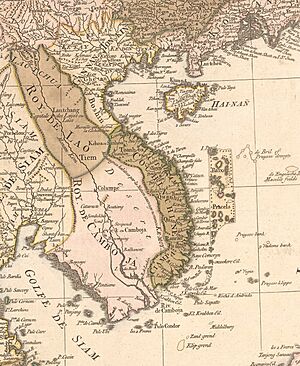
In 1863, King Norodom signed a treaty with France, making Cambodia a French protectorate. This period lasted until 1953. During World War II, Japan briefly occupied Cambodia. In 1941, Norodom Sihanouk became king. France thought he would be easy to control. However, under King Sihanouk, Cambodia gained independence from France on November 9, 1953.
A Time of Conflict and Change (1953–1992)
In 1955, Sihanouk stepped down as king to become prime minister. He became head of state again in 1960. During the Vietnam War, Sihanouk tried to keep Cambodia neutral. He allowed Vietnamese communist forces to use parts of Cambodia as a safe area.
In 1970, while Sihanouk was away, a military coup led by General Lon Nol removed him from power. The new government, called the Khmer Republic, was supported by the United States. The North Vietnamese and Viet Cong forces then attacked the new government. Sihanouk urged his supporters to fight the new government, which led to the Cambodian Civil War.
The Khmer Rouge rebels gained support and power. From 1970 to 1972, the conflict was mainly between the Cambodian government and North Vietnamese forces. As the Vietnamese communists took control of Cambodian areas, they helped the Khmer Rouge grow stronger. In 1970, North Vietnam invaded Cambodia at the request of the Khmer Rouge. In response, the US and South Vietnamese forces entered Cambodia to destroy North Vietnamese bases.
On New Year's Day 1975, communist troops launched a major attack. The Lon Nol government in Phnom Penh surrendered on April 17, 1975.
The Khmer Rouge Era (1975–1978)
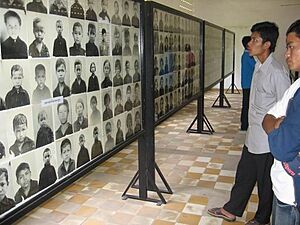
The Khmer Rouge regime, led by Pol Pot, ruled Cambodia from 1975 to 1979. This period is known as the Cambodian genocide. It is estimated that about 1 to 3 million people died during this time, which was about a quarter of the population. Many people fled to Thailand. The regime especially targeted ethnic minority groups and professionals like doctors and teachers. Religious buildings were also destroyed.
Recovery and Modern Cambodia (1978–Present)
In November 1978, Vietnamese troops invaded Cambodia and removed the Khmer Rouge from power. They set up a new government called the People's Republic of Kampuchea (PRK). This new state was supported by Vietnam and the Soviet Union.
However, a government-in-exile formed in 1981, made up of the Khmer Rouge, a royalist group led by Sihanouk, and another group called the Khmer People's National Liberation Front. This group was recognized by the United Nations. Peace talks began in Paris in 1989 and ended in 1991 with a peace agreement. The UN then helped with a ceasefire, refugees, and disarmament.
In 1993, the monarchy was brought back, and Norodom Sihanouk became King again. The first post-war election was held, coordinated by the UN. The election led to a power-sharing agreement between different parties. In 1997, there was a coup led by Prime Minister Hun Sen, who took more power for his party. After this, Cambodia joined the Association of Southeast Asian Nations (ASEAN) in 1999.
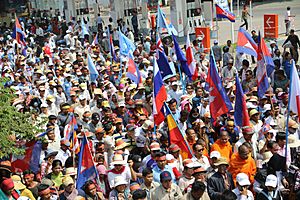
Norodom Sihamoni became King in 2004 after his father, Sihanouk, stepped down. Cambodia's economy grew quickly in the 2000s and 2010s, with support from China. A special court, the Khmer Rouge Tribunal, was set up to investigate crimes from the Khmer Rouge period. In 2010, Kang Kek Iew was found guilty of war crimes.
After the 2013 election, there were protests due to claims of unfair voting. In 2017, the main opposition party was dissolved. This led to the ruling party winning almost all seats in the 2018 election. Prime Minister Hun Sen, who had been in power since 1985, stepped down in August 2023. His son, Hun Manet, became the new prime minister after the 2023 election. Hun Sen became president of the Senate in 2024.
Cambodia's Natural World
Land and Water Features
Cambodia is located in the tropics, between 10° and 15°N latitude and 102° and 108°E longitude. It has a 443-kilometer (275-mile) coastline along the Gulf of Thailand.
The country's center is a low-lying plain. This plain is surrounded by higher lands and small mountains. It includes the Tonle Sap (Great Lake) and the upper parts of the Mekong River delta. Forests cover about 46% of Cambodia's land.
To the north, the plain meets a sandstone cliff called the Dângrêk Mountains. This cliff stretches over 200 miles (320 km) and rises sharply from the plain. The Mekong River flows through eastern Cambodia. East of the Mekong, the plains become forested mountains and high plateaus that reach into Laos and Vietnam.
In southwestern Cambodia, the Krâvanh Mountains and the Dâmrei Mountains form another highland area. This region covers much of the land between the Tonle Sap and the Gulf of Thailand. Phnom Aural, Cambodia's highest peak, is in this area, rising to 1,813 meters (5,949 feet). The southern coast is a narrow, wooded lowland strip, separated from the central plain by these southwestern highlands.
The most unique feature is the Tonle Sap lake. It measures about 2,590 square kilometers (1,000 square miles) in the dry season. But it expands to about 24,605 square kilometers (9,500 square miles) during the rainy season. This area is densely populated and used for growing rice. Much of it is a protected biosphere reserve.
Weather and Seasons
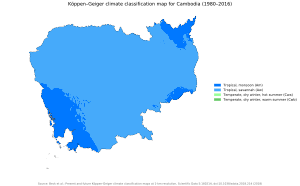
Cambodia's weather is shaped by monsoons, like other parts of Southeast Asia. It has distinct wet and dry seasons. Temperatures range from 21°C (70°F) to 35°C (95°F).
Southwest monsoons bring rain from May to October. The northeast monsoon brings the dry season from November to April. The heaviest rain falls in September and October, while January and February are the driest months.
Cambodia is very vulnerable to climate change. Shortages of clean water, extreme floods, mudslides, and rising sea levels are major concerns. Climate change has also affected the Tonle Sap lake, impacting food supply for many people.
Cambodia has two main seasons. The rainy season (May to October) has temperatures around 22°C (72°F) and high humidity. The dry season (November to April) can see temperatures rise to 40°C (104°F) around April. Flooding happens almost every year.
Nature and Protecting Wildlife
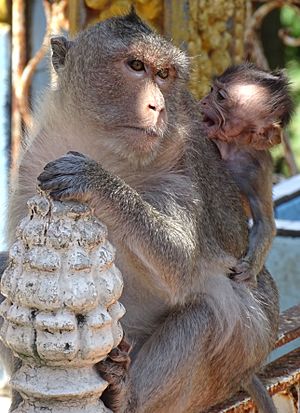
Cambodia has rich biodiversity due to its seasonal tropical forests and river systems. There are 212 mammal species, 536 bird species, 240 reptile species, and many fish species. Much of this wildlife lives around the Tonle Sap Lake and its protected area.
The Tonle Sap Biosphere Reserve protects the lake and nine nearby provinces. It was recognized by UNESCO in 1997. Other important natural areas include the forests of Mondolkiri and Ratanakiri provinces, and the Cardamom Mountains.
However, Cambodia has one of the highest rates of deforestation in the world. Primary forest cover has dropped significantly. This loss of habitat threatens many endangered species. Reasons for deforestation include illegal logging and clearing land for construction or farming.
Plans for new dams on the Mekong River, especially in Laos, also pose a risk. These dams could harm fish populations, which are a main source of protein for Cambodians. They could also reduce the rich soil needed for farming in Vietnam.
The Cambodian government and environmental groups are working together to address these issues. A new plan aims to promote green and sustainable growth for the country.
How Cambodia is Divided
Cambodia is divided into 25 provinces and one special municipality (Phnom Penh). These are the main administrative areas.
The provinces are further divided into 159 districts and 26 municipalities. These districts and municipalities are then split into smaller units called communes and quarters.
|
How Cambodia is Governed
Political System and Leaders
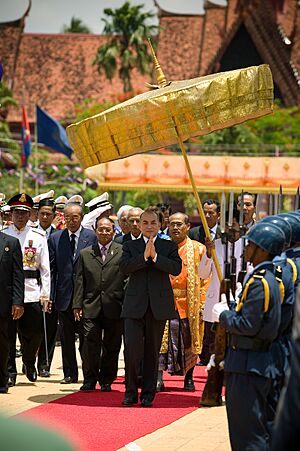
Cambodia has a king and a parliament with two houses: the National Assembly and the Senate. Members of the 123-seat National Assembly are elected for five-year terms. The Senate has 61 seats; some are chosen by the king and National Assembly, and others are elected by local officials. Senators serve six-year terms.
While Cambodia is officially a multi-party democracy, the Cambodian People's Party (CPP) has been very dominant. Prime Minister Hun Sen, who was in power since 1985, stepped down in August 2023. His son, Hun Manet, became the new prime minister. Hun Sen remains a powerful figure as the leader of the CPP and became president of the Senate in 2024.
Relations with Other Countries
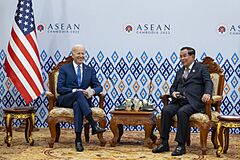
Cambodia has diplomatic ties with many countries. It has embassies from its Asian neighbors and important countries like the US, China, and Japan.
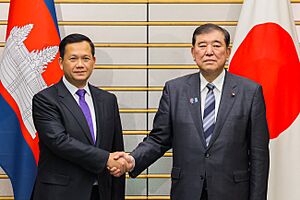
Some border disagreements still exist between Cambodia and its neighbors, like Vietnam and Thailand. For example, there have been disputes over land near the Preah Vihear Temple with Thailand.
Cambodia has grown closer to China in recent years. A Chinese company built a deep-water port in Koh Kong province. Cambodia's support is important to China in its efforts to claim disputed areas in the South China Sea. Cambodia is a member of ASEAN, and its support helps China in regional discussions.
Cambodia is ranked 70th globally for peacefulness in 2024.
Military Forces
Cambodia has its own military, the Royal Cambodian Armed Forces. The country has signed the UN treaty on the Prohibition of Nuclear Weapons.
Political Culture and Challenges
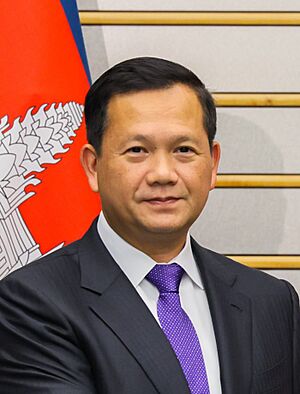
Prime Minister Hun Sen, a former Khmer Rouge commander, held strong power for many years. In 1997, he led a military action to remove his co-prime minister, Prince Norodom Ranariddh.
The Cambodian government has faced accusations of corruption, especially in land sales to foreign investors. This has led to many villagers losing their homes. Cambodia is often listed as one of the most corrupt governments globally.
In 2017, Cambodia's Supreme Court dissolved the main opposition party. This led to a more controlled political system.
Human Rights Situation
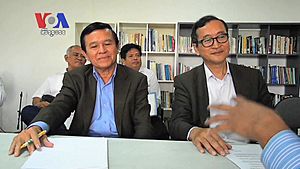
Reports from the US State Department mention that forces linked to the ruling party have been accused of serious abuses. These include unlawful killings and torture.
There have been reports of forced land evictions. Land has been taken from many Cambodians over the past decade. This is often linked to self-enrichment and maintaining power by certain groups. Organizations estimate that hundreds of thousands of people have been negatively affected by land grabbing.
In 2018, a UN expert expressed concerns about limits on media, free speech, and political participation before the national election. Some government critics have been arrested for allegedly spreading false information.
Cambodia's Economy
Cambodia has oil and natural gas deposits off its coast. These were found in 2005 but are mostly unused due to disagreements with Thailand.
Concerns about political stability and corruption can discourage foreign investment. However, Cambodia receives aid from other countries and organizations. For example, the Asian Development Bank has provided significant loans and grants.
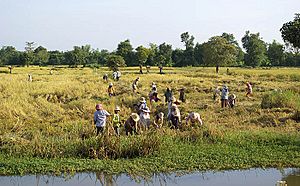
In 2015, Cambodia was ranked among the worst places for organized labor rights. In 2016, a new Law on Trade Unions was adopted. This law aims to improve working conditions and wages.
Clothing Industry
The clothing industry is the biggest part of Cambodia's manufacturing. It makes up 80% of the country's exports. In 2012, exports reached $4.61 billion.
The Better Factories Cambodia program helps improve working conditions in garment factories. It also boosts the industry's ability to compete globally. This program has helped improve the lives of many Cambodian workers. It ensures fair wages, social benefits, and has almost eliminated child labor in the sector.
Travel and Tourism
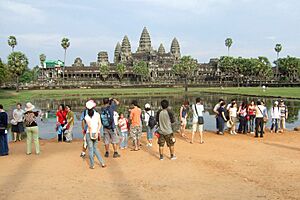
Tourism is Cambodia's second-largest source of income after the clothing industry. In 2023, over 5.4 million international visitors came to Cambodia. Tourism provides jobs for about 2.5 million Cambodians.
Besides Phnom Penh and Angkor Wat, popular places include Sihanoukville with its beaches, and Battambang. The areas around Kampot and Kep are also interesting. Tourism has grown steadily since the 1993 elections.
Most international visitors in 2018 were Chinese. Tourism brought in over $4.4 billion in 2018. The main attractions are the Angkor Wat historical park, Sihanoukville's beaches, Phnom Penh, and the country's many casinos.
Transportation Systems
Cambodia has two main railway lines, totaling about 612 kilometers (380 miles). These lines connect the capital to Sihanoukville on the southern coast. Train services have restarted, offering a safer way to travel than by road.
Road accidents are a serious concern in Cambodia. The number of road deaths has increased significantly.
The Mekong and Tonle Sap rivers are important waterways. They provide about 3,700 kilometers (2,300 miles) of navigable routes all year.
As the economy grows, more people use cars, though motorcycles are still very common. Rickshaws pulled by bicycles are being replaced by carriages attached to motorcycles.
Cambodia has three commercial airports. In 2018, they handled a record 10 million passengers.
Science and Technology Growth
Cambodia has a National Committee for Science and Technology. This committee includes representatives from 11 ministries. Most of the country's 33 public universities are overseen by the Ministry of Education, Youth and Sports.
In 2010, a policy for research development in education was approved. This was the first step towards a national plan for research and development in universities. The country's first National Science and Technology Master Plan 2014–2020 was launched in 2014. It aims to build a strong science and technology base to promote new ideas, especially in farming and information technology. In 2024, Cambodia ranked 103rd in the Global Innovation Index.
Energy Sources
Cambodia has good potential for developing renewable energy sources. It is a good example for other countries in Southeast Asia for holding solar power auctions. To attract more investment in renewable energy, the government could improve its rules and make it easier for international investors to enter the market. Cambodia is very vulnerable to climate change, so developing more renewable energy is important.
People and Culture
Population and Demographics
| Historical population | ||
|---|---|---|
| Year | Pop. | ±% p.a. |
| 1962 | 5,728,771 | — |
| 1980 | 6,600,000 | +0.79% |
| 1994 | 9,900,000 | +2.94% |
| 1996 | 10,700,000 | +3.96% |
| 1998 | 11,437,656 | +3.39% |
| 2004 | 12,800,000 | +1.89% |
| 2008 | 13,395,682 | +1.14% |
| 2013 | 14,700,000 | +1.88% |
| 2019 | 15,552,211 | +0.94% |
| National Institute of Statistics: General Population Census of the Kingdom of Cambodia 2019, Chapter 2, p. 6 | ||
Cambodia's first official census was in 1921. After 1962, there was a long gap until 1998 due to civil conflicts.
As of 2010, half of Cambodia's population was younger than 22 years old. There are more females than males, especially among those over 65. In 2018, the average number of children per woman was 2.5. This was lower than 4.0 in 2000. Women in cities have fewer children than those in rural areas.
Diverse Ethnic Groups
Template:Ethnic map Most of Cambodia's population (95.8%) are ethnic Khmer. They speak the Khmer language, which is the country's only official language. Cambodia's population is quite uniform. Minority groups include Chams (1.8%), Vietnamese (0.5%), and Chinese (0.6%).
The Vietnamese are the second-largest ethnic minority. They mostly live in the southeastern provinces. While both Khmer and Vietnamese languages are related, their cultures are different. This is because early Khmers were influenced by India, while Vietnamese culture was influenced by China.
Languages Spoken
The Khmer language belongs to the Mon–Khmer language family. French was once widely used in government and education. Some schools and universities still teach in French. Cambodia is also a member of La Francophonie, a group of French-speaking countries.
Since 1993, English has become more common. It is now replacing French as the main foreign language. English is taught in universities, and street signs are often in both Khmer and English.
Religious Beliefs
Theravada Buddhism is the official religion of Cambodia. Over 95% of the population practices Buddhism. There are about 4,392 Buddhist temples across the country. Islam is followed by about 2% of the population, mainly by the Cham people.
Health and Well-being
In 2021, the average life expectancy in Cambodia was 75 years, a big improvement from 55 years in 1995. Healthcare is provided by both public and private services. Trust in health providers is important for people to use healthcare.
The infant mortality rate has decreased significantly. In 1998, 86 out of every 1,000 babies died, but in 2018, this number dropped to 24.
Unfortunately, unexploded land mines have caused many deaths and injuries since 1970. The number of landmine casualties has decreased over the years. Cambodia hopes to be free of landmines by 2025.
In 2024, Cambodia's score on the Global Hunger Index was 14.7, which means it has a moderate level of hunger.
Education System
In 2019, about 88.5% of Cambodians could read and write. Literacy rates are slightly higher for men than for women.
The education system has improved, especially in getting more children into primary school. There are also efforts to help disadvantaged children access education. Cambodia has invested in vocational education, especially in rural areas, to help with poverty and unemployment.
Historically, education was mainly offered by Buddhist temples, mostly for boys. Child labor has been a challenge for education. Studies show that many working children are still in school, but their jobs can affect their learning and lead to them dropping out. Parental attitudes also play a role in children's school performance.
Crime and Safety
In 2017, Cambodia's homicide rate was 2.4 per 100,000 people.
In August 2019, the Prime Minister banned new online gambling licenses. This was because some foreigners used online gambling to cheat people.
Cambodian Culture
Stories and Festivals
Traditionally, Khmer people recorded stories and prayers on Tra leaves (palm-leaf manuscripts). These books contain legends, versions of the Ramayana, and Buddhist texts.
Bon Om Touk (Cambodian Water & Moon Festival) is the most popular national festival. It happens at the end of the rainy season when the Mekong River's water levels drop. About 10% of Cambodia's population attends this event each year. People play games, thank the moon, watch fireworks, and enjoy boat races.
Every year, Cambodians visit temples for Pchum Ben (Ancestors' Day). During this 15-day festival, people offer prayers and food to the spirits of their deceased relatives. It is a time to remember those who died during the Khmer Rouge regime.
Delicious Food
Rice is a main food in Cambodia, like in other Southeast Asian countries. Fish from the Mekong and Tonlé Sap rivers is also a big part of the diet.
French influence can be seen in dishes like Cambodian red curry, often eaten with toasted baguette bread. Kuyteav is a popular pork broth noodle soup. Kampot pepper is famous and often served with crab.
Tea is grown in Mondulkiri and Kirirom. Te krolap is a strong tea. Lemon tea is also popular. Coffee beans are often imported, but local coffee can be found.
Cambodia has breweries in Sihanoukville and Phnom Penh. There are also growing numbers of smaller breweries. Rice wine is another alcoholic drink, sometimes flavored with fruits or herbs.
Traditional Dance
Khmer classical dance is a beautiful art form from the royal courts. Dancers perform in costumes for entertainment or ceremonies. They tell traditional stories and epic poems like Reamker, which is Cambodia's version of the Ramayana.
Cambodian folk dance celebrates the country's different cultural groups. These dances started in villages and are often performed by villagers for villagers. The movements are less formal, and dancers wear everyday clothes. Folk dances are usually faster and show themes of daily life, love, or warding off bad spirits.
Music of Cambodia
Traditional Cambodian music has a long history, dating back to the Khmer Empire.
Popular music uses Western instruments or a mix of traditional and Western ones. Dance music is created for social dances. Singers like Sinn Sisamouth, Ros Sereysothea, and Pen Ran from the 1960s and 1970s are considered classic pop artists. Many singers from that era were tragically lost during the Khmer Rouge period.
In the 1980s, artists like Keo Surath continued the legacy of classic singers. The 1980s and 1990s saw the rise of kantrum, a music style from the Khmer Surin people.
See also
 In Spanish: Camboya para niños
In Spanish: Camboya para niños




